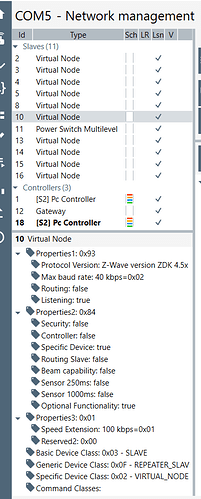I bought another QolSys IQ2+ for a rental property I'm setting up, and was curious to see if I could pair HE as a secondary controller to a panel that was in its factory default configuration.
Interestingly, it worked. There are no zwave devices on the panel, but eight entries showed up on the HE side. I tried adding a zwave bulb to the alarm panel, but it didn't automatically show up in HE like it would with ST as a secondary.
So I thought I would remove HE as a secondary and try again. Doesn't seem like there's any "unlearn" function in HE, so after resetting the zwave radio and a few reboots, I was able to again add HE as a secondary. But then I couldn't even get into the zwave details page, it just hung. Eventually I rebooted the hub and this is what is now showing:
On the alarm panel there are only 2 zwave devices: 11 is the zwave bulb, and 12 is the HE hub (no idea why it started numbering at 11 instead of 2)
I have no idea what devices 1-5 and 7-10 are. Looks like HE can talk to 2 through 5 so something is responding, but what? 8, 9 and 10 are in a failed state, but HE seems to think there's a real device at 10, but it doesn't do anything. The data for 10 is:
- deviceId: 12344
- deviceType: 18260
- manufacturer: 335
- inClusters: 0x5E,0x86,0x72,0x5A,0x85,0x59,0x73,0x26,0x27,0x70,0x7A
- zwNodeInfo: 93 84 00 03 0F 02
The data for 11 (the bulb that works) is:
- deviceId: 12344
- deviceType: 18260
- manufacturer: 335
- inClusters: 0x5E,0x86,0x72,0x5A,0x85,0x59,0x73,0x26,0x27,0x70,0x7A
- zwNodeInfo: 9C 00 04 11 01 5E 86 72 5A 85 5C 59 73 26 27 70 7A 68 23
If I set 11 to Generic Z-Wave Smart Dimmer, it actually works.
Any idea what's going on here? Perhaps HE is incorrectly parsing the info the primary is passing to it?
Edit
I cleared and paired my ZStick as a secondary to the new alarm panel and all these wierd nodes show up as Virtual Nodes, whatever that means.
I highlighted device 10 which HE thinks is some sort of real device.
I have a zniffer device but it just arrived yesterday and haven't had a chance to configure it yet.



